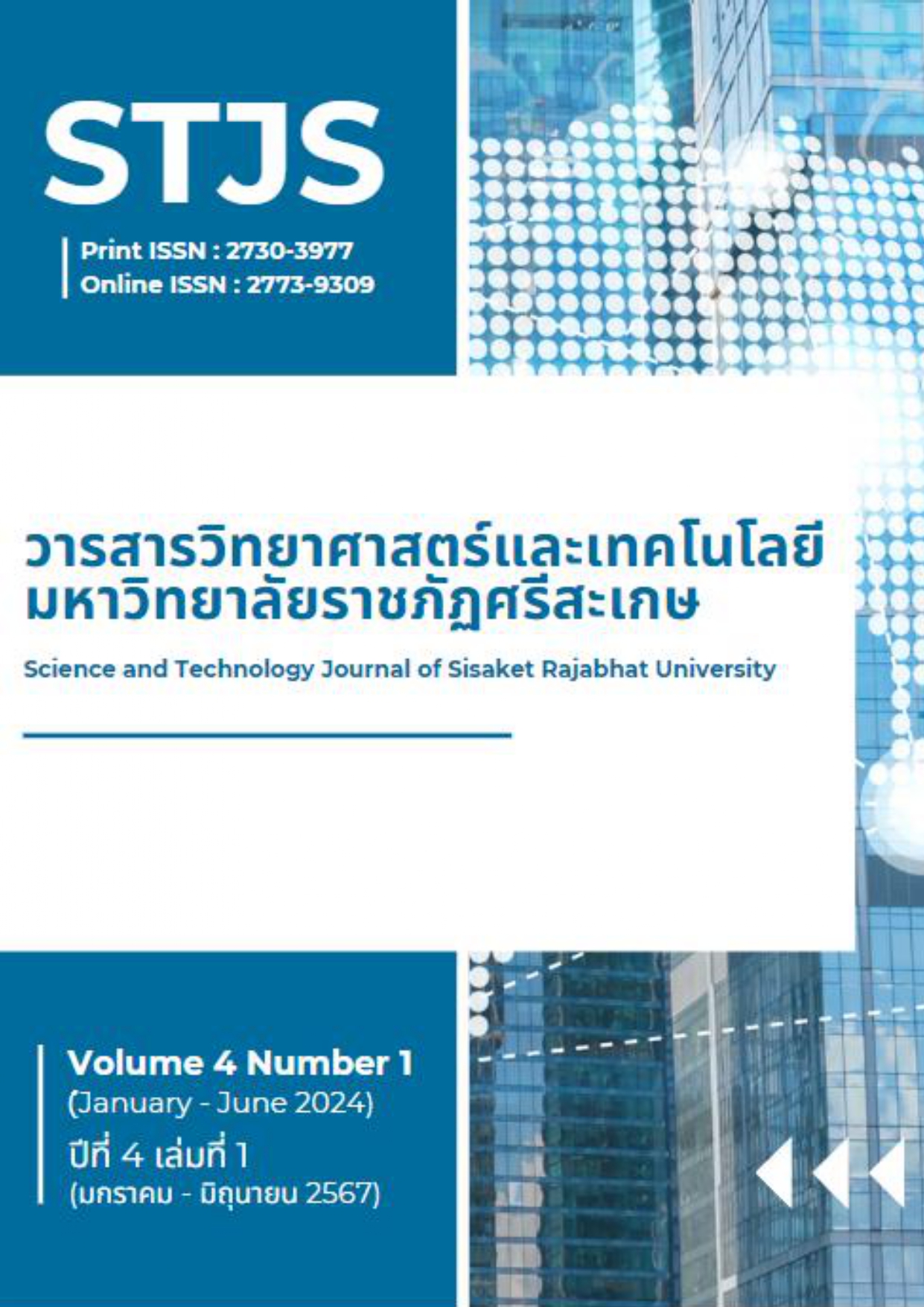การศึกษาผลของอุณหภูมิการเก็บรักษาที่มีต่อคุณภาพของผลิตภัณฑ์ขนมลากรอบ
Main Article Content
บทคัดย่อ
Article Details

อนุญาตภายใต้เงื่อนไข Creative Commons Attribution-NonCommercial-NoDerivatives 4.0 International License.
เนื้อหาและข้อมูลในบทความที่ลงตีพิมพ์ในวารสารวิทยาศาสตร์และเทคโนโลยี มหาวิทยาลัยราชภัฏศรีสะเกษ ถือเป็นข้อคิดเห็นและความรับผิดชอบของผู้เขียนบทความโดยตรงซึ่งกองบรรณาธิการวารสาร ไม่จำเป็นต้องเห็นด้วย หรือร่วมรับผิดชอบใด ๆ
บทความ ข้อมูล เนื้อหา รูปภาพ ฯลฯ ที่ได้รับการตีพิมพ์ในวารสารวิทยาศาสตร์และเทคโนโลยี มหาวิทยาลัยราชภัฏศรีสะเกษ ถือเป็นลิขสิทธิ์ของวิทยาศาสตร์และเทคโนโลยี มหาวิทยาลัยราชภัฏศรีสะเกษ หากบุคคลหรือหน่วยงานใดต้องการนำทั้งหมดหรือส่วนหนึ่งส่วนใดไปเผยแพร่ต่อหรือเพื่อกระทำการใด จะต้องได้รับอนุญาตเป็นลายลักอักษรจากวารสารวิทยาศาสตร์และเทคโนโลยี มหาวิทยาลัยราชภัฏศรีสะเกษ ก่อนเท่านั้น
เอกสารอ้างอิง
American Oil Chemists' Society (AOCS). (2003). Official methods and recommended practices of the American Oil Chemists’ Society. 4thed. Firestone.
Association of Official Analytical Chemists (AOAC). (2002). Official methods of analysis of AOAC international. 18thed. The United States of America.
Association of Official Analytical Chemists (AOAC). (2000). Official methods of analysis of AOAC international. 17thed. The United States of America.
Ayranci, E., Ayranci, G., & Dogantan, Z. (1990). Moisture sorption isotherms of dried apricot, fig and raisin at 20 C and 36 C. Journal of food science, 55(6), 1591-1593.
Baker, GL., Sims, CA., Gorbet, DA., Sanders, TH., & O'keefe, SF. (2002). Storage water activity effect on oxidation and sensory properties of high‐oleic peanuts. Journal of food science, 67(5), 1600-1603.
Bell, LN. (1995). Kinetics of non-enzymatic browning in amorphous solid systems: distinguishing the effects of water activity and the glass transition. Food Research International, 28(6), 591-597.
Bird, P., Flannery, J., Crowley, E., Agin, J., Goins, D., & Jechorek, R. (2015). Evaluation of the 3M™ Petrifilm™ rapid yeast and mold count plate for the enumeration of yeast and mold in food: Collaborative study, first action 2014.05. Journal of AOAC International, 98(3), 767-783.
Burnett, DJ., Thielmann, F., & Booth, J. (2004). Determining the critical relative humidity for moisture-induced phase transitions. International journal of pharmaceutics, 287(1-2), 123-133.
Carter, BP., Galloway, MT., Campbell, GS., & Carter, AH. (2015). The critical water activity from dynamic dewpoint isotherms as an indicator of crispness in low moisture cookies, J. Food Meas. Charact, 9(2015), 463–470.
Cheung, PCK., & Mehta, BM. (2015). Handbook of food chemistry (Vol. 11). Berlin: Springer Berlin Heidelberg.
Chutchanok, B. (2020). Thai dessert tradition aspect. Journal of Thai Food Culture, 2(1), 1-13. (in Thai)
Ellin, DM. (2007). Microbial food spoilage-Losses and control strategies. United States of America: Food Research Institute, University of Wisconsin–Madison.
Falade, KO., Adetunji, AI., & Aworh, OC. (2003). Adsorption isotherm and heat of sorption of fresh-and osmo-oven dried plantain slices. European Food Research and Technology, 217, 230-234.
Farhoosh, R., & Esmaeilzadeh Kenari, R. (2009). Anti‐rancidity effects of sesame and rice bran oils on canola oil during deep frying. Journal of the American Oil Chemists' Society, 86(6), 539-544.
Galić, K., Ćurić, D., & Gabrić, D. (2009). Shelf life of packaged bakery goods-A review. Critical reviews in food science and nutrition, 49(5), 405-426.
Gonzales, AP., Naranjo, GB., Leiva, GE., & Malec, LS. (2010). Maillard reaction kinetics in milk powder: Effect of water activity at mild temperatures. International Dairy Journal, 20(1), 40-45.
Harris, M., & Peleg, M. (1996). Patterns of textural changes in brittle cellular cereal foods caused by moisture sorption. Cereal chemistry (USA), 73(2), 225-231.
Hough, G., Buera, MDP., Chirife, J., & Moro, O. (2001). Sensory texture of commercial biscuits as a function of water activity. Journal of texture studies, 32(1), 57-74.
Kruangam, S., & Intipunya, P. (2013). A study of sorption isotherm and quality changes during storage of powdered longan cube. Food and Applied Bioscience Journal, 1(2), 102–111. (in Thai)
Mathlouthi, M., & Rogé, B. (2003). Water vapour sorption isotherms and the caking of food powders. Food chemistry, 82(1), 61-71.
Mollan, MJ., & Celik, M. (1995). The effects of humidity and storage time on the behavior of maltodextrins for direct compression. International journal of pharmaceutics, 114(1), 23-32.
Mrad, ND., Bonazzi, C., Boudhrioua, N., Kechaou, N., & Courtois, F. (2012). Influence of sugar composition on water sorption isotherms and on glass transition in apricots. Journal of Food Engineering, 111(2), 403-411.
Murata, M. (2021). Browning and pigmentation in food through the Maillard reaction. Glycoconjugate Journal, 38, 283-292.
Nagi, HPS., Kaur, J., Dar, BN., & Sharma, S. (2012). Effect of storage period and packaging on the shelf life of cereal bran incorporated biscuits. American Journal of Food Technology, 7(5), 301-310.
Panyathitipong, W., Tempiam, S., Suttha, W., Chomshome, N., & Masavang, S. (2022). Effect of Storage Conditions on Qualities and Water Sorption Isotherm of Khanom La. Trends in Sciences, 19(8), 3466-3466.
Rahman, MS., & Labuza, TP. (1999). Water activity and food preservation [Online]. Retrieved August 1, 2023, from: https://moisturecontrol.weebly.com/uploads/5/3/5/3/53532707/book_ch2-_water_activity_and_food_preservation.pdf
Sablani, SS., Kasapis, S., & Rahman, MS. (2007). Evaluating water activity and glass transition concepts for food stability. Journal of Food Engineering, 78(1), 266-271.
Saša, B., Odon, P., Stane, S., & Julijana, K. (2006). Analysis of surface properties of cellulose ethers and drug release from their matrix tablets. European journal of pharmaceutical sciences, 27(4), 375-383.
Sharma, S., & Riar, CS. (2020). Effect of storage period and packaging materials on textural, phenolic, antioxidant properties of cookies made from raw and germinated minor millet blends flour. Annals: Food Science and Technology, 21(1), 74-85.
Tapia, MS., Alzamora, SM., & Chirife, J. (2020). Effects of water activity (aw) on microbial stability as a hurdle in food preservation. Water activity in foods: Fundamentals and applications, 323-355.
Thanonkaew, A., & Ruangklay, P. (2016). Effect of frying oil on quality changes of khanom la during storage at room temperature. Journal of Rajamangala University of Technology Srivijaya, 8(2), 203-218. (in Thai)
Vadukapuram, N., Hall, C., Tulbek, M., & Niehaus, M. (2014). Physicochemical properties of flaxseed fortified extruded bean snack. International journal of food science, 2014, 478018.
Wang, D., Xiao, H., Lyu, X., Chen, H., & Wei, F. (2023). Lipid oxidation in food science and nutritional health: A comprehensive review. Oil Crop Science.
Weisser, H. (1985). Influence of temperature on sorption equilibra. Dordrecht, Boston, Lancaster: Martinus Nijhoff Publishers.
Yan, Z., Sousa-Gallagher, MJ., & Oliveira, FA. (2008). Sorption isotherms and moisture sorption hysteresis of intermediate moisture content banana. Journal of Food Engineering, 86(3), 342-348.


